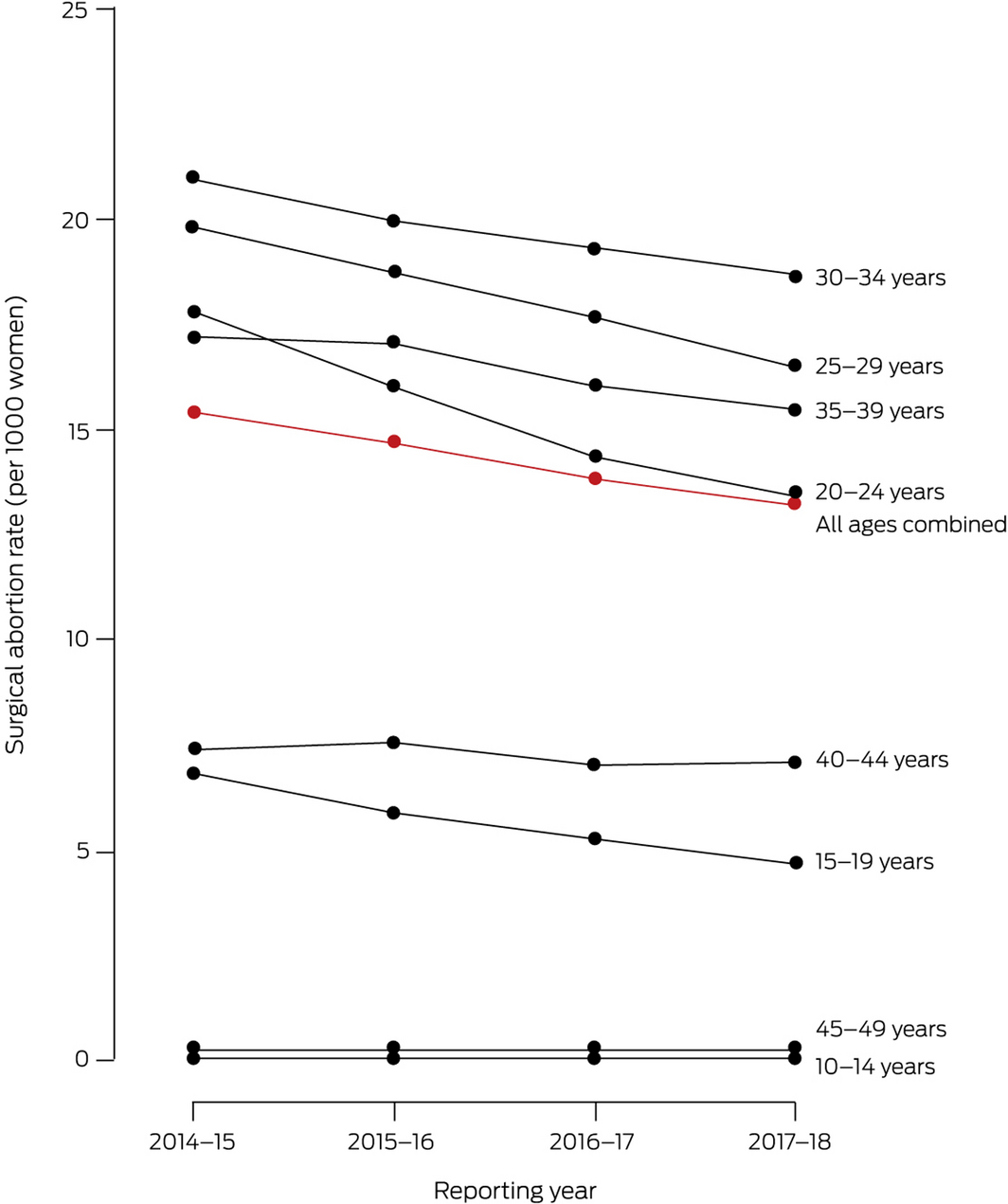It is difficult to estimate the abortion rate in Australia, as most states do not routinely report abortion data, and published national data have been incomplete.1 Consequently, some clinicians and academics have been accused of inflating reported rates for political reasons.2 National data have not been published in the peer‐reviewed literature since 2005.3 However, “abortion with operating room procedure” (65 451 procedures) was reported to be the third most frequent surgical procedure in Victorian hospitals during January 2014 ‒ December 2016.4 Prompted by this report, we sought to provide an updated estimate of the national abortion rate for women in Australia. Our study was approved by the University of Melbourne Human Research Ethics Committee (2021‐21757‐16379‐2).
First, we analysed publicly available National Hospital Morbidity Database (NHMD) data for 2014–18. The NHMD includes data on all episodes of care in private and public Australian hospitals and day procedure clinics.5 While some data collections do not distinguish between dilatation and curettage procedures for miscarriage or non‐pregnancy‐related conditions and those for inducing an abortion,1 the NHMD categorises separations according to Australian Refined Diagnosis‐Related Groups (AR‐DRG).6 Abortion procedures are defined as “abortion with operating room procedures” in major diagnostic category 14 (pregnancy, childbirth and the puerperium), while non‐pregnancy‐related dilatation and curettage procedures are included in major diagnostic category 13 (diseases and disorders of the female reproductive system). NHMD reports these data by five‐year age group but otherwise aggregated for the entire Australian population. We estimated the number of surgical abortions by combining the numbers of “abortions with operating room procedure” (AR‐DRG: O05Z) and “abortions without operating room procedures” (AR‐DRG version 7.0, 2013‒16: O63Z; version 8.0, 2016‒18: O63A or O63B). Age‐ and year‐specific abortion rates for 2014‒15 to 2017‒18 were calculated by dividing the number of abortions by the corresponding population number.7
Second, we extracted numbers of prescriptions for combination mifepristone/misoprostol (MS‐2 Step) for medical abortion from the Pharmaceutical Benefits Scheme (PBS) database.8 Prior to PBS listing of this agent in 2013, medical abortion was available only from authorised prescribers, and the number of prescriptions was not publicly available.
The number of surgical abortions for all women declined from 75 514 (15.4 per 1000 women aged 15–44 years) in 2014‒15 to 67 546 (13.2 per 1000 women aged 15–44 years) in 2017‒18 (Box). The mean annual decline in rate (Poisson log‐linear model) was 5.1% (95% confidence interval, 4.8‒5.4%). The number of prescriptions of combination mifepristone/misoprostol for medical abortion increased from 3220 in 2014‒15 to 20 741 in 2017‒18.
The total number of abortions for all women during 2017–18 was therefore 88 287 (17.3 abortions per 1000 women aged 15–44 years), slightly higher than the often cited estimate of 80 000 abortions per year.1 This rate is lower than estimates published in 2005 for the year 2003 (19.7 abortions per 1000 women aged 15–44 years1,3), but marginally higher than more recent rate estimates for 2015‒19: in Australia and New Zealand, 15 abortions per 1000 women aged 15–49 years (80% uncertainty interval [UI], 12–19 abortions per 1000 women) and in high income countries, 15 abortions per 1000 women (80% UI, 13–16 abortions per 1000 women).9
While we can confidently estimate the number of abortions in Australia, we will have slightly overestimated the number of pregnancies terminated, as about 5% of medical abortions are incomplete or complicated; in these cases, women may be admitted to hospital for surgical abortions.10
The combination of publicly available NHMD and PBS data can be used to study changes in abortion rate in more detail than previously. Surgical abortion is a common medical procedure in Australia, but the rate has declined by 5.1% per year since the PBS listing of combination mifepristone/misoprostol. We recommend further analysis of local data, both to ensure that this medical procedure is provided across Australia, and to contribute to the evidence base informing interventions to improve sexual and reproductive health.
Box – Rates of surgical abortion performed for all women in hospitals and day clinics, Australia, 2015‒18, by 5‐year age group

Received 22 October 2020, accepted 10 May 2021
- 1. Grayson N, Hargreaves J, Sullivan EA. Use of routinely collected national data sets for reporting on induced abortion in Australia (AIHW cat. no. PER 30; Perinatal Statistics Series no. 17). Sydney: AIHW National Perinatal Statistics Unit, 2005. https://www.aihw.gov.au/reports/mothers‐babies/use‐national‐data‐sets‐reporting‐induced‐abortion/contents/table‐of‐contents (viewed Apr 2021).
- 2. Black KI, Bateson DJ, Goldstone P. Abortion statistics and long‐acting reversible contraception in Australia [letter]. Aust N Z J Obstet Gynaecol 2018; 58: E6–E7.
- 3. Chan A, Sage LC. Estimating Australia’s abortion rates 1985–2003. Med J Aust 2005; 182: 447–452. https://www.mja.com.au/journal/2005/182/9/estimating‐australias‐abortion‐rates‐1985‐2003
- 4. Fehlberg T, Rose J, Guest GD, Watters D. The surgical burden of disease and perioperative mortality in patients admitted to hospitals in Victoria, Australia: a population‐level observational study. BMJ Open 2019; 9: e028671.
- 5. Australian Institute of Health and Welfare. National Hospitals Data Collection. Updated 14 Apr 2021. https://www.aihw.gov.au/about‐our‐data/our‐data‐collections/national‐hospitals‐data‐collection (viewed Apr 2021).
- 6. Australian Institute of Health and Welfare. Australian refined diagnosis‐related groups (AR‐DRG) data cubes (Cat. no. WEB 216). Updated 7 Dec 2020. https://www.aihw.gov.au/reports/hospitals/ar‐drg‐data‐cubes/contents/data‐cubes (viewed Apr 2021).
- 7. Australian Bureau of Statistics. Regional population by age and sex. Statistics about the population by age and sex for Australia’s capital cities and regions. Updated 20 Aug 2020. https://www.abs.gov.au/statistics/people/population/regional‐population‐age‐and‐sex/latest‐release (viewed Apr 2021).
- 8. Services Australia. Pharmaceutical Benefits Schedule item reports. http://medicarestatistics.humanservices.gov.au/statistics/pbs_item.jsp (viewed Apr 2021).
- 9. Bearak J, Popinchalk A, Ganatra B, et al. Unintended pregnancy and abortion by income, region, and the legal status of abortion: estimates from a comprehensive model for 1990–2019. Lancet Global Health 2020; 8: E1152–E1161.
- 10. Goldstone P, Walker C, Hawtin K. Efficacy and safety of mifepristone–buccal misoprostol for early medical abortion in an Australian clinical setting. Aust N Z J Obstet Gynaecol 2017; 57: 366–371.





No relevant disclosures.